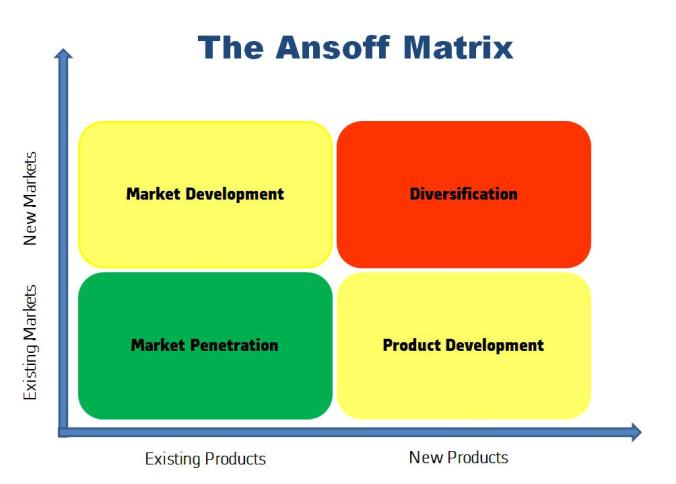As mentioned in the previous post, business success involves thinking and planning ahead. The two main vectors of commercial growth are product development and market development. The Ansoff Matrix is probably one of the oldest business strategy tools, designed to help businesses think about strategies for growth and their associated risks. Developed by Igor Ansoff, a Russian-American Mathematician and Business Strategist, it was published in a 1957 Harvard Business Review article “Strategies for Diversification“.

Image from Wikipedia Commons “Ansoff Matrix”
There are four main strategies and the colours represent the extent of risks involved:
1. Market Penetration
Market penetration involves increasing sales of existing product in the existing market. It is the lowest risk strategy as the business has all it needs to make and sell its product in a familiar market, so no new research or development is necessary.
Some key ways to increase market penetration:
- Competitive pricing (low vs premium)
- Advertising/promotion
- Increase sales effort
- Taking away existing market from competitors e.g. through differentiation or acquiring competitor
- Increase use by existing customers e.g. loyalty programs
- Increase ease of purchase
- Educate potential customers
- Increase distribution channels
- Modifying product packaging to increase appeal
2. Market Development
Market development involves selling the same product to new market(s). The vertical movement indicates some risks are involved as one is venturing into new markets. Resources are allocated to expanding marketing efforts so a thorough understanding of the new market is necessary to ensure profit is reaped. The business should also have the ability to cope with increased demands on production.
Ways to develop new markets:
- Increase geographical reach e.g. sell to other countries or locations
- Use different sales channels e.g. online vs physical store
- Advertise through different media
- Perform market segmentation to identify new customer groups by demography, psychography
- Pricing strategy to reach different markets
- Explore selling to other businesses (B2B) instead of direct to customers (B2C) or vice versa
3. Product Development
This involves enhancing the product, increasing the product range or developing new products with related technologies to sell to the same markets. Again, some risks are involved with the horizontal movement. This is necessary when the product is losing its appeal and is falling behind the competition, or alternatively if the business wants to be the first in the market with a novel product.
This is done by:
- Investing in research and development to develop new products
- Acquiring the rights to produce someone else’s product
- Joint ownership of new product with another company
- Buying over the product and rebranding it under the company’s name
- Understanding changing customer needs and creating new products to address them
4. Diversification
Diversification is the highest risk strategy as it involves branching out into a completely new field with new product(s) and new market(s). Some reasons given for diversification include to avoid being technologically obsolete, to distribute risk, to make use of increased production capability, to reinvest earnings, to increase profits by entering a lucrative industry, develop capabilities in a new “growth” industry, or to obtain top management.
There are 3 types of diversification
- Vertical diversification – where the company decides to make its own production components or materials instead of relying on vendors. The technology involved in making these parts can be very different from assembling the final product, hence it does involve a substantial learning curve.
- Horizontal diversification – where the product is completely different from the existing one but builds on the company’s existing know-how in technology, finance and marketing.
- Lateral diversification – where the company delves into a completely new industry. Like when Coca-Cola bought movie production company Columbia Pictures.
Interestingly, there is also a Personal Ansoff Matrix which one can use for career development. Igor Ansoff nicely summarized the necessity of staying ahead of the growth curve by quoting the Red Queen (from Alice in Wonderland):